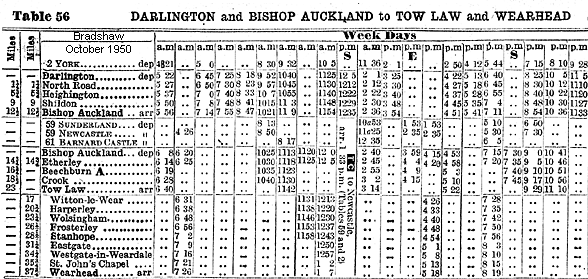|
Notes: To the east of the station were extensive sidings, which
included accommodation for the local coal merchant. The Wear
Valley Goods, which ran twice daily from Bishop Auckland Goods
yard, serviced the yard. The goods called at all stations between
Wear Valley Junction and Wearhead, dropping off or picking up
goods as required.
Upstairs in the station house, the Directors of the NER often
used to meet in the long room known as the ‘board room’.
It was built for the Directors of the original railway when
it termintated at Wolsingham.
 |
The sidings closed to goods 6th September 1982. The unusual
shaped signal box closed in June 1984, with both signalmen being
transferred to Witton-Le-Wear. At that time with only 2 cement
trains a day and a morning goods the box was only open approx
07.30 to 17.00 and only had one signal man. The other was the
relief for the whole line west of Shildon. |
The station was reopened in July 2004 as part of The
Weardale Railway Project but due to financial problems there
was no service in 2005.
BRIEF HISTORY OF THE WEAR VALLEY
RAILWAY (this is a shortened version taken from the Weardale
Railway Project web site. Click here
for the full version)
It was in the early days of the Stockton & Darlington Railway
Company, that a railway to tap the mineral wealth of Weardale
was first considered. However, it wasn't until November 1843
when the Bishop Auckland & Weardale Railway was opened from
Shildon Junction to Crook that any real attempt was made to
penetrate the dale. The line was leased and worked by the Stockton
& Darlington Railway. An extension of this line in 1845
from Crook to Waskerley was opened to serve as another outlet
for the Derwent Iron Company at Consett. The section of line
was originally called the Weardale Extension Railway but later
under a merger with the line from Stanhope to Consett, was known
as the Wear & Derwent Junction Railway.
A plan to penetrate Weardale proper was covered by the Wear
Valley Act of July 1845, which was to provide a line from Witton
Junction (Wear Valley Junction) on the Bishop Auckland &
Weardale Railway to Frosterley, with a connecting branch to
Bishopley, this opened on 3rd August 1847..
In 1862 the Wear Valley line was extended to Stanhope by the
Frosterley & Stanhope Railway, mainly to reach the Newlandside
Estate on the south side of the town where large quantities
of limestone were known to exist.
The final extension of the Wear Valley line to Wearhead was
opened on 21st October 1895. It was impossible to extend the
line from the existing station at Stanhope and therefore a new
one had to be built.
Between Eastgate and Westgate at Cambo
Keels, sidings were established to serve the Weardale Iron
Company's Heights limestone quarry. This quarry is still operational
today.
The passenger train service survived until 29th June 1953.
Up until closure, four trains per day had served the stations
of Witton-Le-Wear, Harperley, Wolsingham, Frosterley, Stanhope,
Eastgate, Westgate-in-Weardale, St. Johns Chapel and Wearhead.
The freight service to Wearhead survived until 1961 when the
line was cut back the St. John's Chapel. West of Eastgate followed
in 1968, which is the present terminus.
Eastgate cement works were established in 1964 and brought
new life to the Wear valley line. Utilising purpose built container
wagons, cement was transported mainly by rail from the plant
to Teesside, Tyneside and Scotland. This operation ceased on
17th March 1993.
The line which existed until 2004 was single throughout between
Eastgate and Shildon. There is a connecting spur into Bishop
Auckland station - the terminus of the 'Heritage Line' passenger
service from Darlington. A summer only Sunday passenger train
service to Stanhope operated as an extension to the Darlington
service between 1988 & 1992. The success of this service
was instrumental in reopening the station at Etherley (renamed
Witton Park), in August 1991.
| A campaign to save the line west of Bishop Auckland, now known
as the Weardale Railway, began in 1993 with the threat of closure
and track uplift a real possibility after the last cement train
ran. Until 2004, the line was mothballed, but purchase by Weardale
Railways Limited has now been achieved and the first works trains
began running in 2004 in preparation for |
 |
the reopening of the
first section between Stanhope and Wolsingham in July 2004.
In February 2005 Weardale Railways Ltd, the company operating
the line ran into financial difficulties and it was necessary
to call in an administrator. No service operated during 2005
but the Weardale Railway Project are hopeful of of a satisfactory
outcome in the near future with a resumption of services some
time in 2006.
See The
Weardale Railway Project web site. Tickets from Michael Stewart
Click here
for Roy Lambeth's memories of the Wear Valley line in the late
1950's & 1960's
To see the other
stations on the Wear Valley Railway click on the station name:
Bishop Auckland,
Etherley, Wear
Valley Junction, Witton-le-Wear,
Harperley, Frosterley,
Stanhope (1st),
Stanhope (2nd), Eastgate,
Westgate-in-Weardale,
St. John's Chapel
& Wearhead |


15.jpg)
old9.jpg)
8.jpg)

 Home
Page
Home
Page




old4.jpg) Wolsingham Station
circa early 1950s.
Wolsingham Station
circa early 1950s.